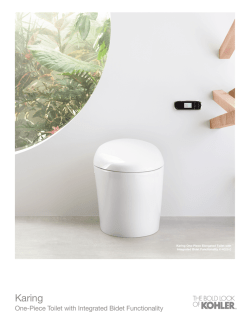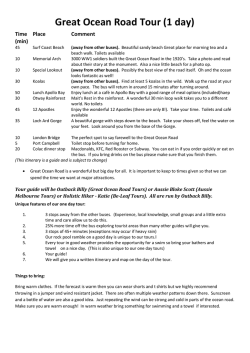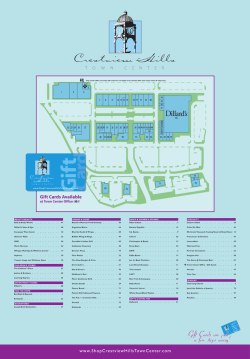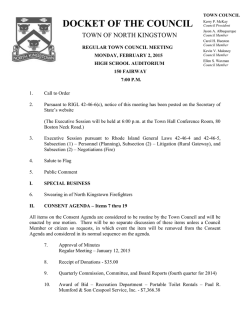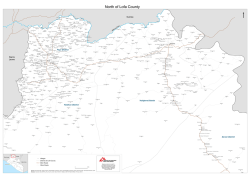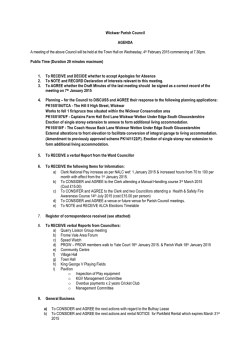
Item 6 - Town Centre Conveniences
1. REPORT TO: Employment, Business and Investment Scrutiny Committee REPORT NO: HAED/10/15S DATE: 4 February 2015 LEAD MEMBER: Councillor Neil Rogers (Economic Development and Regeneration) CONTACT OFFICER: Peter Scott (Tel: 292405) SUBJECT: Town Centre Conveniences WARD: Smithfield, Grosvenor, Maesydre and Offa PURPOSE OF THE REPORT To consider options for the future operation and opening of Wrexham town centre public conveniences. 2. EXECUTIVE SUMMARY 2.1 The detail of this report has previously been considered by Corporate Land and Buildings Strategy Group on 4 November 2014, when the importance and operation of the five town centre public conveniences, located at Bodhyfryd (Waterworld car park), Albion, Henblas Street, the People’s Market and King Street Bus Station was considered. 2.2 Corporate Land and Buildings Strategy Group agreed to a number of recommendations, including the improvement and extension of the facilities at Henblas Street to create modern female/male disabled facilities. To close the public toilets situated at Waterworld car park once Henblas Street reopens. It was also recommended that the opening hours of the Albion toilets should reduce and that a twenty pence charge should be implemented once facilities have been improved, starting with Henblas Street. It was also agreed to employ a Cleaner/Attendant at the Henblas Street toilets; 2.3 This report explains how the provision of town centre public toilets supports wider objectives of the Council and supports the town centre economy. It also identifies some of the recent problems and proposes a range of options intended to address these issues. 3 RECOMMENDATIONS 3.1 That the Employment, Business and Investment Scrutiny Committee recommend a preferred option for future of town centre conveniences to the Executive Board. REASONS FOR RECOMMENDATIONS To enable the council to effectively manage the Wrexham town centre toilets as directed. Background Information 4.1 Public toilets matter to everybody, regardless of their age,ethnic origin, gender, ability. They are even more important to certain sections of our society, including older people, disabled people, women, families with young children and tourists. Public access to toilets is important for local shops and businesses too. People respond to locations that demonstrate a sense of civic pride, where it is obvious that they are welcomed. Tourists choose their destinations carefully, drawing on their previous impressions, talking to friends and family, looking up feedback on the internet. The work that is being undertaken by this Council and partners on Destination Management links to this. The sense of destination – the extent to which it has met a visitor’s needs and made a strong and positive impression – is therefore vital to secure repeat trade and sustainable economic development in the town centre. 4.2 The Public Health Act 1936 gives local authorities a power to provide public toilets. However, it imposes no duty to do so. This lack of compulsion, together with a perception of nuisance associated with managing them, has arguably resulted in a steady decline in the provision of public toilets in recent years in some other local authority areas. 4.3 Nationally, many organisations are campaigning for better provision of public toilets. It’s difficult to see how this desire can be aligned with dwindling public sector finances. The British Resorts and Destinations Association (BRADA) highlights the importance of good quality public toilets for tourists and other visitors, who make a crucial contribution to many local economies. The National Organisation of Residents’ Association (NORA) points out the negative impact on residents where lack of good provision results in street fouling, an increasing problem because of extended licensing laws. Help the Aged and other groups stress the importance of public toilets to give older people the confidence to leave their homes and to avoid problems arising from isolation and dependency. There is a strong lobby fighting for equal rights for disabled people, including the Changing Places Consortium, which has developed and introduced public toilets that are accessible to severely disabled people. 4.4 Other campaigners work to readdress the inequality of provision for women, arguing that, for a variety of reasons, there should be a 2:1 ratio in favour of women’s toilets, whereas current provision is 1:1 or significantly worse. The British Toilet Association is a campaigning group with 160 members, of whom 61 are local authorities, and promotes the “Loo of the Year” awards to recognise and reward excellence in public toilets. National Guidance 4.5 The Government’s Strategic Guide on the provision of public toilets, “Improving Public Access to Better Quality Toilets” was published in March 2008. The guide highlights existing powers at the disposal of local authorities that can be used to improve public access to toilets. 4.6 There is a wide range of detailed information and guidance on all areas concerned with the provision of public toilets, including location, design and signage: the Government’s strategic guide is a general overview about the provision of public toilets; the BTA has a list of recommendations and a comprehensive website; and British Standards BS8300 and BS6465 both provide codes of practice for the design of sanitary facilities and scales of provision. 4.7 The British Standard Institute memorandum describes the proposed British Standard BS6465 Part 4, which is based on the current Annex C of BS6465-1:2006, and provides a comprehensive standard for providers of public toilets, which takes into account physical (spatial/geographical) distribution issues, user requirements and design considerations (taking into account the Single Equality Duty 2010) and practical, economic and management issues. Public toilets and other policy priorities 4.8 Enabling different people, with different needs, to make use of public toilets can impact on issues like public health, public behaviour and use of public transport. The town centre toilets link to the Council plan in the context of the strategic themes of Economy (E1) where people want to live, work and visit. 4.9 Social equality and inclusion: a lack of clean, accessible and safe toilets impacts on some people more than others. Some people may feel unable or reluctant to leave their homes and visit areas where they fear they will not be able to find a public toilet. Older people (a growing section of the population in our ageing society), mothers, fathers, and carers with young children, disabled people and people with chronic health problems – all need easy access to suitably equipped public toilet facilities. The Single Equality Act 2010 places additional responsibilities on public authorities in relation to accessible facilities for all Protected Characteristics, specifically for this report; Age, Disability, Sexual Orientation, Gender, Religion and Belief and Pregnancy and Maternity. 4.10 Healthy Communities: - a lack of toilet facilities at the right time in the right place contributes to dirty streets that are unsanitary and unpleasant. A lack of available and appropriate facilities at the right time during the day and night encourages street fouling, and cleaning up the mess is a significant and costly task - especially at the weekend. 4.11 Cleaner, safer, greener communities: public toilets that are badly designed, badly maintained, and poorly located generate a sense of neglect, attracting vandalism, anti-social behaviour and social disorder. 4.12 Destination Management; a positive visitor experience is vital. These issues, if not tackled effectively, can generate a cycle of decline, leading to more entrenched social problems, and seriously impairing quality of place and quality of life for local people. 4.13 Sustainable Transport: People are being encouraged out of their cars and onto public transport, cycling and walking. However, people will not leave their cars at home unless they are confident that they can find a toilet at public transport interchanges and in city centres. 4.14 Disabled people, too, need to know that transport facilities, services and infrastructure will be accessible. Inclusive Mobility, the Department for Transport’s guide to best practice on access to pedestrian and transport infrastructure, stresses the need for toilets to be no less accessible for disabled people than for non-disabled people. 4.15 There are around 10 million disabled people in Great Britain, and disability rates increase with age. The Single Equality Act 2010 requires service providers to make ‘reasonable adjustments’ to allow disabled people to access these services. This is why the Changing Places Initiative outlined in paragraph 5.32 of this report is important. Town Centre Public Conveniences 4.16 The Assets and Economic Development Department currently has responsibility for eight public toilets in the County Borough, including five in Wrexham Town Centre; Female Disabled Sun 7.30 am 6.00 pm 7.30 am 6.00 pm Closed Closed 4 4 1 7.30 am 7.30 am 24 hours 6.00 pm 24 hours 7.30 am 6.00 pm 24 hours Closed Closed 4 - 4 4 2 1 6.00 am 6.00 pm 7.00 am 6.00 pm Closed Closed 2 4 1 9.00 am 4.30 pm 9.00 am 4.30 pm Closed Closed 2 5 1 Open Waterworld Car Park Albion Henblas Street (Ladies only) King Street Bus Station People’s Market* Sat Male Mon-Fri Close Open Close Open Close 4.17 In addition to the Council’s provision of five public conveniences, there are many other toilet facilities in the town centre that can be used by the public. Toilets at Stations, Supermarkets, restaurants and cafes etc. Eagles Meadow has two free, publicly accessible conveniences. These are in addition to the facilities provided by Debenhams and Marks and Spencer for their customers. 4.18 There are also toilets for public use, provided as part of the Community Toilet Scheme (CTS) at the Horse and Jockey public house and Central Station. Payment of £500 p.a. to each provider is made by Welsh Government. There are also numerous toilets in bars, restaurants and coffee shops for the use of customers. On the basis of this evidence it must be concluded that there is considerable provision of toilet facilities in the town centre. Current Costs/Budget 4.19 Operating costs of each of the five conveniences is not transparently clear. The cash limited budget for 2014/15 is shown for three of the five conveniences at £15,959. Clearly, this is an unrealistic financial provision and is not reflective of the actual costs incurred. Actual Expenditure in 2013/14 for Albion, Bodhyfryd and Henblas Street was £30,161. 4.20 Based on the figures for the three toilets for which costs are available, it appears that cleaning costs circa £8,000 - £13,000 for each convenience, - totalling approximately circa £40-65,000 overall for the five facilities. 4.21 A full breakdown of running costs for the Henblas Street, Albion and Bodhyfryd conveniences in 2013/14 is attached to this report as Appendix 1. As indicated above, the running costs of each convenience are between £8,000 and £13,000 p.a. which includes cleaning, NNDR (National Non-Domestic Rates) and utility costs. There is no budget breakdown for the facilities at King Street Bus Station or the People’s Market as these costs are absorbed into the wider running costs of those facilities. It would seem reasonable to assume that the costs of cleaning, NNDR and utilities will be broadly similar to the three facilities where costs are known. In addition, the facilities are subject to vandalism. In 2013/14 around £4,000 was spent on repairs. These costs are met separately from the Assets and Economic Development department’s repair and maintenance budget. Therefore, the total estimated cost in 2013/14 of operating the five town centre conveniences run by this Council is approximately £60,000 p.a. 4.22 Moving forward, work will be undertaken to identify and isolate actual costs of all conveniences located with the town centre to identify true costs. 4.23 Comparative costs to evidence that town centre toilets are being run effectively are difficult to obtain. The ongoing costs of maintaining public toilets vary, depending on the type of public toilet, whether it is attended and level of use. The House of Commons Communities and Local Government committee report ‘The Provision of Public Toilets Twelfth Report of Session (2007–08)’ quotes a business called Healthmatic—a company that designs, supplies and maintains public toilets in the United Kingdom and Ireland. It states: “Average cleaning is around £8-10k per loo, £1000 on consumables, £1,000 on NNDR and capital charges, building repairs, and other costs will vary.” Older facilities need to be updated, to comply with health and safety, and disability legislation. The BTA quotes the figure of £25,000 to £40,000 per year for the cost of maintaining an attended facility. To provide attendants for a public toilet open ten hours a day, seven days a week would require three staff at a salary cost of around £29,000, according to Healthmatics based on costs in 2008. Minimum Standard of Public Toilet Provision 4.24 Due to limited resources there has not been any significant capital and revenue programme designed to bring the Wrexham Town Centre toilets up to a suitable standard. 4.25 It is recommended that a minimum standard for all town centre public toilets is adopted; If possible the following features should be incorporated: Baby Changing facilities – either in a shared common location or in both male and female toilets; Energy conservation measures – including automatic taps/flushes and lighting; In unattended locations, stainless steel fitments, subject to appropriate regular electrical earth-bonding testing; ceramic furniture if facilities are staffed; Time-activated locks on unattended facilities, to maximise operating hours without requiring additional staff time; Plugs which cannot be detached – or a reduced water temperature to remove the need for plugs at all; Hooks for bags/coats in each cubicle; There should be standard public toilet signage across the County Borough (possibly using symbols rather than text to allow for universal recognition, irrespective of language); Additional visible, clear signs for existing public toilets, detailing such information as opening hours and location. Information about public toilet facilities and locations should also be provided in promotional leaflets for both locals and visitors and on local authorities’ websites; They should follow the relevant British Standard guidelines, ensuring that their provision covers the needs of women as well as men. The parliamentary select committee recommended that local authorities aim to provide a ratio of 2:1 public toilet provision in favour of women; Disabled provision to allow as much room as possible (subject to the optimum space standards of BS8300), utilising colour contrast throughout and with easyuse levers on taps and doors and, ideally, a pull-down shelf; Adequate provision of both sanitary and general waste bins; and The standardisation, as far as is possible, of all furniture and fittings, in all conveniences, would make maintenance easier, possibly cheaper, and minimise the closure of facilities for repair works. Anti-social behaviour 4.26 There is much evidence of anti-social behaviour and inappropriate use of Wrexham Town Centre public toilets. There are also significant issues with the homeless, who seek shelter in the toilets, especially in the winter months. The toilets in the People’s market closed between February and October 2014 as a result of sustained misuse and anti-social behaviour. As a result, people are avoiding town centre toilets as they feel that they are unsafe to use. In addition, some of the measures adopted to try to deal with the problems, such as the use of blue lights to deter drug users, or sharps boxes for needle disposal, further alarm the general public who, quite naturally, prefer not to share space with people who use public toilets as a base for drug use. Other towns and cities have found that introducing charges for use – and / or providing toilet attendants reduces vandalism and miss-use and can help the community regain confidence in public toilets. These options and the issues relating to them are explored further in subsequent paragraphs. Options going forward 4.27 It is recommended that a sequence of options and decisions are considered. The first two decisions relate to whether the Wrexham Town Centre conveniences should remain in their present form. The third option relates to a policy on charging. The fourth option relates to the provision of attendants. After the four options are considered there is a table summarising proposals and recommendations. The final option relates the possible extension of the Community Toilet Scheme. That said, the status quo in respect of the Council’s provision of town centre public conveniences is not a sustainable position, because budget pressures and also because it will be increasingly difficult to compete with other towns and retail environments without improving the physical fabric and appearance of these facilities. Public toilets need to be clean, well maintained and feel safe. Currently these outcomes are not being achieved. There is no capital provision identified to undertake works and therefore difficult decisions may have to be taken if these facilities are to be improved within fixed or reduced budgets. Option 1 - To continue to keep all five toilets open or select some town centre toilets for closure 4.28 The revenue budget for Town Centre toilets was overspent in 2013/14 by approximately £14,000 and is projected to be overspent by a similar amount in 2014/15. Savings are necessary in order to bring the costs in line with the cash limited budget. In addition, some of the Council’s public conveniences are not situated in the best locations. In the years since they first opened, pedestrian flow around the town centre has changed as has customer expectations. 4.29 Fiscal pressure and changes in footfall patterns suggest that consideration must be given to the rationalisation & closure of some facilities to create savings in the revenue budget and fund additional cleaning. It is therefore proposed to; close the facility at Bodhyfryd. This would save an estimated £9,000 p.a. immediately running costs. Liabilities for the NNDR and standing charges for water and electricity would continue to be incurred; Demolition would save a total of £13,000 p.a reduce the opening hours at Albion to 18 hours a week from 8pm until approximately 2am/3am, on Thursday, Friday and Saturday. This will support the night time economy. Reduced opening would immediately save the cost of four days cleaning and utility costs. In theory it will also reduce repairs from vandalism. Any savings could contribute to employing a Door Supervisor/ attendant, - creating a safer and more pleasant facility. However, this plan needs to be flexible, given that there is a proposal emerging to situate an alcohol Treatment Centre at this location. Wrexham had an Alcohol Treatment Facility in temporary bases in 2013 and 2014 during the busy festive periods which were run on a multi-agency basis with partners from, This Council, North Wales Police, Health Street Pastors, British Red Cross etc. The success of the treatment centre in reducing the demand on public sector organisations during the busy period (e.g. Police, Accident & Emergency etc) have led to the proposal that a more permanent base be found. This will be funded and operated on a multi-agency basis. The aim is that this will be in place by Oct/Nov 2015 in time for the busy Christmas period; and the above closure of these facilities should be reviewed periodically. It is recognised that varied opening times need to be accompanied by clear signage that lists opening hours and gives details of of the nearest open toilet. ( see comments from public consolation para 5.7.3) After a period of12 months and if successful, The building at Bodhyfryd could be demolished and six car park spaces created. However, the cost of demolition is estimated at £25,000, with the reinstatement of the area as a car park costing an additional £5,000. A car park space in this location generates £4 per day – an average of £800 p.a.per space, 6 spaces £4,800 p.a. Potentially this income could be diverted from car parks budget to assist with the revenue costs of operating improved town centre toilets. However, the proposals for the future of this location will be influenced & determined by the direction of the Wrexham town centre master plan. Rationale for proposed actions 4.30 It is recognised that closure of Bodhyfryd may be unpopular with some people. Anecdotally, taxi drivers and driving instructors in particular use the Bodhyfryd facility and would need to make alternative arrangements. However, there are publicly accessible and supervised facilities in the near vicinity in Council owned premises at Waterworld and the Memorial Hall. Both locations currently allow access, at management discretion, although this is not widely promoted. The remaining facilities at Albion, Henblas Street and the King Street Bus Station could be upgraded over a three year period. Proposed Changes to the People’s market may change the public toilet provision offered at that location. Exactly how they might be upgraded and operated will be determined by the options considered further in this report. At Henblas Street, Listed Building Consent would be needed to convert, what is, a grade II listed building and any alterations proposed will need careful consideration and appropriate design solutions and materials to ensure the significance of the building is protected”. 4.31 The Attendant responsible for cleaning the bus station currently cleans at Bodhyfryd and Albion. Once the opening hours of these facilities are reduced closed, resources can be fully concentrated on the operation at the bus station. In addition, the overall saving could be used as a contribution to part fund an attendant to supervise Henblas Street. Option 2 - Upgrade facilities or remain at current standard. 4.32 This option is not conditional on any revenue savings generated in option two. Whilst all of the town centre toilets require refurbishment, it is proposed to begin with the Henblas Street toilet block, because it is strategically positioned on a main pedestrian route linking the West and East sides of the town. It is physically part of the General market and has the floorspace available to extend the toilet accommodation and to transform it into a flagship operation, providing modern facilities for both male and female, in addition to providing a ‘Changing Places’ facility for people with disabilities. (One Changing Places facility is already provided in Eagles Meadow) The specification requirement of a ‘Changing Places’ facility ensures that there is sufficient space for disabled people and their carers; they also have to have the right equipment, including a height adjustable changing bench and a hoist. Having this toilet provision in the ‘traditional;’ town centre would make a dramatic difference to the lives of hundreds of people. 4.33 Additional floorspace.to accommodate this extended facility could be created by closing perimeter stalls 1 and 2 in the General Market, and incorporating the space to created extended toilet facilities. Access would of course, remain on Henblas Street. Permission would be needed to convert, what is, a grade II listed building. Theoretically, the loss of these two market stalls would result in a combined loss of £7698 pa, to the income of the market. However, neither stall has been occupied for any length of time in recent years. The upgrade of Henblas Street convenience would take between 8 and 12 weeks and cost in the region of £100,000, potentially funded from the capital reserve, created as part of the 2013/14 revenue out turn. Option 3 - Charging 4.34 The concept of charging needs to be approached with a certain amount of care due to the potential negative impact. However, with the alternative option being closure, reducing costs and increasing income could make charging the only sustainable option. 4.35 If charging is introduced, the entrance to the toilets will be controlled by a paddle gate system located within the entrance area. The entrance and layout can be configured to allow use of this facility without payment (entry to disabled toilet is via National Key Scheme). 4.36 There are no figures available in respect of current usage. However, If it is assumed that the town centre toilets have 200 users per day on average, and that a 20 pence charge is made for using the toilets, it would potentially generate around £12k per annum (£40 per day income x 300 days). Negative impact of charges 4.37 There are many possible effects of charging on usage. Different groups are affected by charging in different ways. For example, tourists are less price sensitive to toilet charging than local people as they have little knowledge of the alternative provision. 4.38 For local people, the impact on introducing a charge will depend on the quality of the facilities available. There is extensive evidence from other local authorities that people are quite prepared to pay to use public toilets providing that they are clean, tidy and safe. 4.39 Evidence from other local authorities generally suggests that overall usage will reduce by 50% when a charge is introduced. 4.40 Local people may also question about having to ‘pay twice’ for toilets, once through their ‘council tax’ and secondly at the door. The answer to this question will be to improve the quality of the facilities and services being provided. 4.41 Taxi Drivers/Driving Instructors/Outdoor Market Stall Holders will also be affected. This particular group of users generally consider that they should have free access to toilet facilities and there may be a considerable amount of negative comment from this group and there may be a marked decline in their usage. Positive impact of charges 4.42 Evidence suggests that charging for toilets will result in lower anti-social behaviour for the simple reason that vandals and drug abusers are less likely to pay to use the toilet than regular users. The introduction of Closed Circuit Television (CCTV) to entrances and lobby areas of public toilets should provide a further reduction in anti-social behaviour. The toilets will therefore stay in a better condition through the introduction of charging, thus helping to reduce costs and provide a better environment for genuine users. 4.43 Successfully generating revenue will depend on a variety of factors, including the price. The British Toilet Association (BTA) recommends a charge of 20p for most parts of the UK outside of major cities. Tourists, with their relatively low price sensitivity have the potential to provide the most income generation. However, as most toilets are mixed use between visitors and locals, it would be prudent to consider the ratio of users and the alternatives in the area. In general the BTA suggest a charge of 50p, while a mixed use would command a charge of 20p. Whilst the toilets in the Town centre are used extensively by tourists and visitors, introducing a charge of 50p may be a step too far and a 20p charge would probably be far more acceptable. 4.44 One of the benefits of introducing the charge will be a net positive impact on operating costs. Some of the costs are directly attributable to the number of users, for example consumables, water, and maintenance requirements (wear and tear and vandalism). Whilst there is not a direct correlation between the running costs and number of users it is reasonable to assume that there will be a reduction in running costs and the fact that unrestricted access is taken away and that people have to pay to use the facilities, should result in a reduction in vandalism and anti-social behaviour. Consequently, a reduction in ‘inappropriate’ use of the toilet facilities should result in the amount of cleaning and maintenance that is required. Option 4 – Attendants 4.45 All of the public toilets in Wrexham Town Centre are currently unattended. They are opened, closed and cleaned by staff from the Assets and Economic Development Department. Up until June 2006 the toilets were staffed by two full time attendants who each worked 40 hours per week. 4.46 Between 2006 and Jan 2009 the toilets were staffed by one full time employee working 37 hours per week. 4.47 Following retirement the toilet opening/cleaning duties were then carried out by the Town centre Sweepers up until the toilets were transferred to Assets and Economic Development. 4.48 If savings identified as option two are accepted and a charging policy introduced as proposed in option three, sufficient savings and income could potentially be generated to employ a full time Cleaner/Attendant, most likely to be graded at L02 within the Council’s pay scale schedule. The Cleaner/Attendant would be based at the refurbished Henblas Street facility. A eight hour day 9am- 5pm six days a week would be proposed. One post would cover a maximum of 37 hours, whereas the opening time would be 48 hrs per week. Cover for holidays and other absence could possibly be covered by other staff associated with the wider town centre, such as Market Attendants, depending on how the town centre staff are organised, going forward in the future. 4.49 Ideally, an Attendant/Private Door Supervisors would look after the Albion toilets during certain opening hours, to ensure safety. However, costs may be prohibitive and it may not be possible to fund this on a permanent or regular basis. A Door Supervisor for short periods at key times, as was provided over Christmas 2012, may be possible within the provision of revised budgets. This will depend upon income and expenditure going forward. 4.50 It must be pointed out that Attendants can play a role beyond keeping toilets clean and well-stocked: they can also collect the fee from users (and provide change), assist people with special access needs, and deter vandalism and inappropriate use. Regularly inspected toilets can also help the community regain confidence in public toilets. 4.51 The House of Commons Communities and Local Government committee report ‘The Provision of Public Toilets Twelfth Report of Session (2007–08) quotes City of London Corporation memorandum that highlights the extra costs connected with Staffed facilities, but states: “In the City’s experience, however, the costs of staffing are on the whole outweighed by the benefit of reduced costs in dealing with the effects of vandalism and other examples of anti-social behaviour. Option 5 - Extend the Community Toilet Scheme (CTS) 4.52 We could enhance our provision of public toilets in Wrexham Town Centre with a Community Toilet Scheme. This would involve working with businesses across the town centre to make more toilets available to the public across longer opening hours and in more convenient locations. 4.53 The Welsh Assembly Government’s Community Toilet Grant Scheme needs local authorities and local businesses such as pubs, post offices and shops, to work together to provide cleaner, safer and more accessible toilets for the general public. How does the Community Toilet Grant Scheme work? 4.54 The Community Toilet Scheme enables local businesses like pubs, restaurants and shops, to work together with the council to make more clean, safe and accessible toilets available to the public. All the businesses involved in the scheme would allow non-customers to use their toilet facilities during their normal opening hours. Participating businesses would display a sticker in the window, showing that the public are welcome to use the toilet facilities without necessarily having to ask or make a purchase. Currently, there are two businesses in Wrexham Town Centre that have adopted the scheme: Central Station, 15 - 17 Hill Street, Wrexham LL11 1SN currently closed during the day but is due to re-open in the near future under the new name of ‘The Waiting Room’, with new proprietors. The Horse & Jockey, 32 Hope Street, Wrexham. LL11 1BG 9:00am - 11:00pm Monday - Saturday 9:00am - 12:00 noon Sunday It is not known at this stage whether either of the above two premises will continue their participation in the Community Toilet Scheme. 4.55 See a list of participating Community Toilet Scheme premises. Members of the public can use toilet facilities during the premises opening hours and without the need to make a purchase. Businesses have the right to refuse entry in exceptional circumstances. 4.56 Participating premises will be required to keep their toilets safe, clean, accessible and well-stocked. In return, businesses and organisations will receive up to £500 for taking part. 4.57 There are some groups and individuals who might feel uncomfortable going into a pub to go to the toilet. The scheme must cover a variety of outlets to ensure that toilet facilities are available for a wide range of users, over a substantial part of the day and night. The signage in respect of the CTS schemes needs to be extremely clear and welcoming to the public. Currently it’s not, neither has it been well publicised in the local media. 4.58 In considering the above options the Corporate Land and Buildings Strategy Group meeting on 4 November 2014 ( HAED/19/14) resolved that recommend to Executive Board to: 1 2 3 4 5 4.59 temporarily close the public toilets at Henblas Street and upgrade them to provide modern female/male disabled facilities; close and ‘mothball’ the public toilets located at Bodhyfryd (Waterworld car park) once Henblas street reopens. This will save £16k annually in revenue costs. The saving will fund an Attendant at Henblas street; reduce opening times of the Albion toilets by closing them on Monday, Tuesday and Wednesday each week. This will save money on cleaning and security; introduce a 20 pence charge for use of public toilet facilities in Wrexham Town Centre, once they’ve been improved, starting with Henblas Street; and employ a Cleaner/Attendant to staff the Henblas Street toilets; If the remaining town centre toilets are kept as a public service The Assets and Economic Development Department will try to find funding to improve each toilet in turn. Options in respect of improvement will be evaluated. Potentially, moving forward, a combination of savings and revenue generated from the 20p charge to improve King street bus station toilets in 2016/17 and Albion in 2017/18 4.60 Policy Framework – A wide range of policy priority linkages is outlined in paragraphs 4.8 – 4.14. Enabling different people, with different needs, to make use of public toilets can impact on issues like public health, public behaviour and use of public transport. The town centre toilets link to the Council plan 2012-16 in the context of the strategic themes of Economy (E1) where people want to live, work and visit. 4.61 Budget – Town Centre toilets were overspent in 2013/14 by £14,000 and are projected to be overspent by a similar amount in 2014/15. Any savings made would need to be retained in order to bring the costs in line with the cash limited budget. Given the severe financial climate, Members need to be certain that investing in the provision of town centre public conveniences, which is a discretionary service, is a priority for the Council. More effort is needed in encouraging businesses in the town centre to participate in the Community Toilet Scheme. However, if Members consider that upgrading current facilities is a priority, this could be funded from the Capital reserve which was created as part of the 2013/14 Revenue Outturn (HF/28/14). 4.62Legal –– any legal comments are referred to within the report. 4.63 Staffing – The proposal to staff Henblas Street conveniences with an attendant/Cleaner would require the creation of a new full time post and the amendment of the job descriptions of other staff. 4.64 Equality/Human Rights – Equality impact assessment AED/EIA00054/2014. Full assessment not required. 4.65 Risks – 1. Capital costs of the works identified exceed those stated – mitigation; effective project management, detailed design, procurement, and construction; 2. Decline in footfall associated with introduction of charges, mitigation; effective communications, promotion of a high quality product, with appropriate signage; 3. Negative comments associated with closures and reduced opening hours.mitigation; effective communication. 5. CONSULTATION 5.1 To improve the understanding of people’s needs, extensive consultation was undertaken between 15 December 2014 and 16 January 2015. A range of organisations were consulted including AVOW, The Town Centre Forum, Wrexham Business Group, Market Traders, Shopmobility users, Wrexham Over 50’s group, the Reshaping Services Equality Group, the Wrexham Trans group, the Truckers Toilets UK Campaign, Members of the British Toilet Association and Community Councils 5.2 In addition, a Survey Monkey questionnaire was posted on Wrexham.com and the Council website, to encourage as many people and groups as possible to be involved. 5.3 A summary of the responses from Survey Monkey are attached as appendix 2 A total of 90 people responded. – Not everyone answered all of the questions, - some questions were skipped. 5.4 There was a disappointingly low response to the on-line questionnaire from young people, with only 2 people under 18 participating. The majority of people who contributed (72%) were over 40 years old. Most people (76%) who responded considered the standard of Council toilets in Wrexham town centre was either poor or very poor. (Q8) A high percentage, (72%) considered that Wrexham town centre toilets compared badly or very badly with those in other towns. A total of 68% (Q9) rated cleanliness either poor or very poor. Paradoxically, 9% rated cleanliness as good. A total (Q10) of 77.2% indicated that they felt the toilets were unsafe. Not surprisingly in that context, a question about the proposed introduction of an Attendant ( Q11) gave a very positive response in favour, with 86.35% supporting the idea. The final question (Q12) related to the introduction of a small charge. A total of 65 people indicated that they were in favour, with 53 people indicating that they would be prepared to pay a 20 pence charge with 7 indicating that a 30 pence charge would be acceptable. The remaining 5 people were prepared to pay 50 pence. However, a total of 27 people,(28% of people who completed the survey), indicated that they would not prepared to pay a charge at all. Many in this group commented along the lines that they considered they had paid already as Ratepayers. 5.5 Recognising specific needs of vulnerable customers of Shopmobility, a specific questionnaire and link to the Survey Monkey was provided and given to users prior to vehicle rental. 5.6 Offa Community Council wrote to welcome and support the proposals for improvement. However, they indicated the need for the King Street toilets in particular to be open on Sunday They also hoped that the refurbished toilets on Henblas Street would also open on Sunday. Another comment made was the lack of facilities (apart from the Albion) open in the evenings after 6pm. Commenting that in particular more facilities for the disabled were needed in the evening. 5.7 Other comments from other groups and individuals indicated that; 1. Comment; Fees: 20p would seem a reasonable sum to pay for most people if this means that toilets are clean and well maintained. That said those people needing to visit a toilet more frequently for whatever reason - a medical condition or with a child for example - may find going to the loo becomes expensive. However charging a fee is more likely to reduce misuse as most vandals don't like to pay to vandalise! 2. Comment; Car park toilets: Generally speaking having toilets in a carpark is thought to be an ideal location. There is plenty of activity which deters vandals and those arriving by car do not have to venture far for a toilet. 3. Comment; Varied opening times: These are fine as long as these are clearly stated! Also the nearest open toilet facility should be clearly stated. There is nothing more distressing than to finally locate a toilet in an unfamiliar area only to find it's closed. 'Holding on’ contributes to bladder and bowel problems, particularly in young children. 4 Comment; Attendants: These people are worth their weight in gold and many receive deserved recognition at the Loo of the Year Awards <www.loo.co.uk >. Having an attendant deters vandals, ensures facilities are clean and maintained and contributes to general safety. Visitors always remember their toilet experiences and a positive visit means they are more likely to return in the future which ultimately helps to boost the local economy. 5 Comment; The Arts Hub or Techniquest development of TJ Hughes. To proceed with upgrading Henblas Street conveniences at this time may be premature. Could toilets for the public be incorporated into either one or both of the new facilities. 5.8 Consultation also took place with the town centre business community. Both the Town Centre Forum and Wrexham Business Group. Were consulted on Tuesday 6 January 2015. The consensus of the groups was that payment for clean, nice toilet provision was perfectly acceptable. There was only one voice against the proposals. There was no objection to the closure of Bodhyfryd toilets. 5.9 The Managers of both Waterworld and the Memorial Hall expressed concern with regard to the proposed closure of Bodhyfryd public toilets and the possible adverse impact that the displaced anti-social behaviour may have on these premises. 5.10 One of the Council’s Strategic and Performance Directors has made a comment that children should be free. Members may wish to consider this suggestion and decide whether or not to support it. 6. EVALUATION OF OPTIONS 6.1 Options are evaluated and explained in detail in the body of the report. However, in summary; Option 1 - To continue to keep all five toilets open-or select some town centre toilets for closure 6.2 The revenue budget for Town Centre toilets was overspent in 2013/14 by £14,000 and is projected to be overspent by a similar amount in 2014/15. Savings are necessary in order to bring the costs in line with the cash limited budget. In addition, there are five public toilets operated within half a mile radius. Some rationalisation is therefore required. 6.3 Closure of Bodhyfryd would immediately save an estimated £9,000 p.a. in direct operating costs. If eventually demolished circa £13,000 would be saved. There are alternative publicly accessible facilities in the near vicinity. The Attendant responsible for cleaning the toilets at King Street Bus Station currently cleans at Bodhyfryd and Albion. Once the opening hours of these facilities are reduced resources can be fully concentrated on the operation at the bus station. In addition, the overall saving could be used as a contribution to part fund an Attendant to provide an on-site presence at Henblas Street. Option 2 Upgrade facilities or remain at current standard 6.4 Whilst all of the town centre toilets require refurbishment, it is proposed to begin with the Henblas Street toilet block. This is because it is located on a strategic pedestrian route linking the West and East sides of the town. It has the capacity available to extend transform it into a flagship operation, providing modern facilities for both male and female and disabled people Option 3 - Charging 6.5 Introducing a charge will generate income and help balance the budget. It is reasonable to assume that there will also be a reduction in running costs because there should result in a reduction in vandalism and anti-social behaviour. The reduction in ‘inappropriate’ use of the toilet facilities should result in the amount of cleaning and maintenance required. Option 4 – Attendants 6.6 All of the public toilets in Wrexham Town Centre are currently unattended. If savings identified as option two are accepted and a charging policy introduced as proposed in option four, sufficient savings and income could be generated to employ a full time Attendant, based at the refurbished Henblas Street facility. Option 5 - Extend the Community Toilet Scheme (CTS) 6.7 We should attempt enhance our provision of public toilets in Wrexham Town Centre with a Community Toilet Scheme. This would involve working with businesses across the town centre to make more toilets available to the public across longer opening hours and in more convenient locations. BACKGROUND PAPERS Changing Places Toilets LOCATION Internet WEBSITE INFO. http://www.changingplaces.org/the_campaign /what_are_changing_pla ces_toilets_.aspx Appendix 1 Toilet ALBION TOILETS Electricity NNDR Building Cleaning Other Costs Total ALBION TOILETS BODHYFRYD TOILETS Electricity NNDR Water Building Cleaning Total BODHYFRYD TOILETS HENBLAS STREET TOILETS Electricity Gas NNDR Water Building Cleaning Cleaning Consumables Other Costs Staff Costs Income Total HENBLAS STREET TOILETS TOTAL TOWN CENTRE TOILETS 2013/14 Expenditure £ 2014/15 Projected Expenditure £ 2015/16 Proposed Expenditure £ 1,848 2,830 4,901 66 9,645 2,000 2,885 6,359 0 11,244 1,000 2,950 3,180 0 7,130 1,283 2,366 3,960 4,900 12,509 1,500 2,413 3,000 5,953 12,866 0 2,462 500 0 2,962 255 281 510 1,999 4,926 0 36 0 8,007 210 266 520 2,365 6,425 0 0 0 0 9,786 500 500 530 2,400 0 500 1,000 16,000 -12,000 9,430 30,161 33,896 19,522 * 250 people per day @ 20p = £50 per day * 6 days per week = £300 * 40 weeks = £12,000. *
© Copyright 2025
